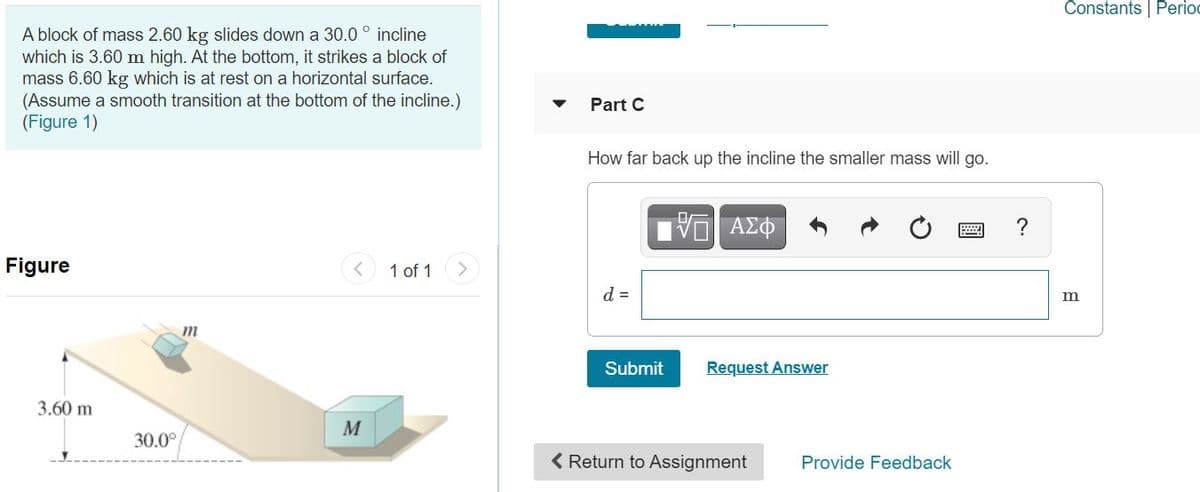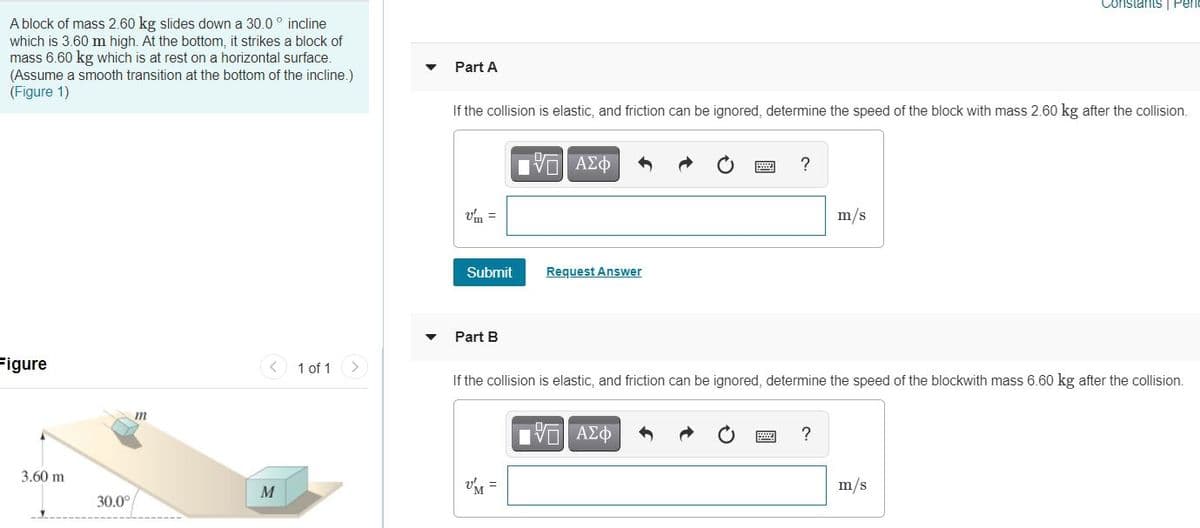A block of mass 2.60 kg slides down a 30.0 ° incline which is 3.60 m high. At the bottom, it strikes a block of mass 6.60 kg which is at rest on a horizontal surface. (Assume a smooth transition at the bottom of the incline.) (Figure 1) Part A If the collision is elastic, and friction can be ignored, determine the speed of the block with mass 2.60 kg after the collision. ? vm = m/s Submit Request Answer Part B igure < 1 of 1 > If the collision is elastic, and friction can be ignored, determine the speed of the blockwith mass 6.60 kg after the collision. ? 3.60 m v = m/s M 30.0° 圓
A block of mass 2.60 kg slides down a 30.0 ° incline which is 3.60 m high. At the bottom, it strikes a block of mass 6.60 kg which is at rest on a horizontal surface. (Assume a smooth transition at the bottom of the incline.) (Figure 1) Part A If the collision is elastic, and friction can be ignored, determine the speed of the block with mass 2.60 kg after the collision. ? vm = m/s Submit Request Answer Part B igure < 1 of 1 > If the collision is elastic, and friction can be ignored, determine the speed of the blockwith mass 6.60 kg after the collision. ? 3.60 m v = m/s M 30.0° 圓
University Physics Volume 1
18th Edition
ISBN:9781938168277
Author:William Moebs, Samuel J. Ling, Jeff Sanny
Publisher:William Moebs, Samuel J. Ling, Jeff Sanny
Chapter9: Linear Momentum And Collisions
Section: Chapter Questions
Problem 103AP: Three skydivers are plummeting earthward. They are initially holding onto each other, but then push...
Related questions
Question
100%
A block of mass 2.60 kg slides down a 30.0 incline which is 3.60 mm high. At the bottom, it strikes a block of mass 6.60 kg which is at rest on a horizontal surface.

Transcribed Image Text:Constants | Perioc
A block of mass 2.60 kg slides down a 30.0 ° incline
which is 3.60 m high. At the bottom, it strikes a block of
mass 6.60 kg which is at rest on a horizontal surface.
(Assume a smooth transition at the bottom of the incline.)
(Figure 1)
Part C
How far back up the incline the smaller mass will go.
ΑΣΦ
Figure
1 of 1
<>
d =
m
Submit
Request Answer
3.60 m
30.0°
< Return to Assignment
Provide Feedback

Transcribed Image Text:Constants | Peri
A block of mass 2.60 kg slides down a 30.0° incline
which is 3.60 m high. At the bottom, it strikes a block of
mass 6.60 kg which is at rest on a horizontal surface.
(Assume a smooth transition at the bottom of the incline.)
(Figure 1)
Part A
If the collision is elastic, and friction can be ignored, determine the speed of the block with mass 2.60 kg after the collision.
?
vin =
m/s
Submit
Request Answer
Part B
Figure
1 of 1 >
If the collision is elastic, and friction can be ignored, determine the speed of the blockwith mass 6.60 kg after the collision.
ΑΣφ
?
3.60 m
M
VM
m/s
30.0°
Expert Solution
This question has been solved!
Explore an expertly crafted, step-by-step solution for a thorough understanding of key concepts.
This is a popular solution!
Trending now
This is a popular solution!
Step by step
Solved in 4 steps

Knowledge Booster
Learn more about
Need a deep-dive on the concept behind this application? Look no further. Learn more about this topic, physics and related others by exploring similar questions and additional content below.Recommended textbooks for you

University Physics Volume 1
Physics
ISBN:
9781938168277
Author:
William Moebs, Samuel J. Ling, Jeff Sanny
Publisher:
OpenStax - Rice University

College Physics
Physics
ISBN:
9781938168000
Author:
Paul Peter Urone, Roger Hinrichs
Publisher:
OpenStax College

University Physics Volume 1
Physics
ISBN:
9781938168277
Author:
William Moebs, Samuel J. Ling, Jeff Sanny
Publisher:
OpenStax - Rice University

College Physics
Physics
ISBN:
9781938168000
Author:
Paul Peter Urone, Roger Hinrichs
Publisher:
OpenStax College